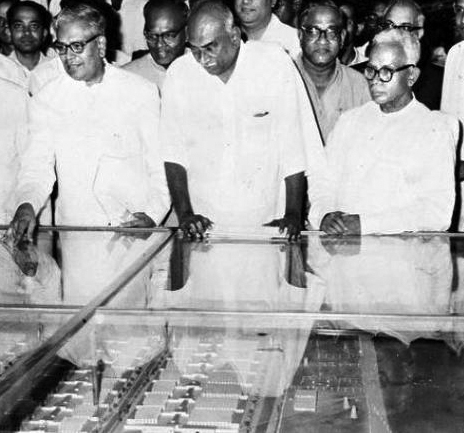Registered with the Registrar of Newspapers for India under R.N.I 53640/91
Vol. XXVII No. 5, June 16-30, 2017
The back story
by N. Venkateshwaran
How Ambattur Industrial Estate became a reality
 Left to right: R.Venkataraman, K. Kamaraj and M. Bhakthavatsalam looking at a model of the Ambattur Industrial Estate at its inauguration on July 3, 1965
Left to right: R.Venkataraman, K. Kamaraj and M. Bhakthavatsalam looking at a model of the Ambattur Industrial Estate at its inauguration on July 3, 1965Ambattur Industrial Estate was the second industrial estate to come up in the State of Madras (the first being the Guindy Industrial Estate). It is the largest among the industrial estates in South-east Asia, spreading over an area of a little over 1,300 acres and having more than 1,800 units. This industrial estate, which became functional in 1964, boasts of a large number of automobile components manufacturers, which, in fact, forced one of the largest truck manufacturers in the country, Tata Engineering & Locomotive Co. Ltd., to open a procurement centre in Madras to facilitate their purchases and interaction with suppliers. The presence of so many auto components producers was the prime reason for several international car producers to set up manufacturing units in and around Madras.
The architect behind this successful industrial contribution was R. Venkataraman, former President of India, when he was the State’s Industries Minister for over ten years. He had first promoted the Guindy Industrial Estate in 1958 – the first of its kind in India – and it became an instant success. He began to think of building on this success.
The State unit of the Congress Party decided to host the A.I.C.C. session in Madras in 1955 and to hold it at Avadi. It expected around 3,000 delegates to attend and arrangements had to be made for their accommodation and food close to the venue. It also expected over 30,000 persons to attend the public meetings on each of the two days when all-India leaders like Jawaharlal Nehru and Sardar Patel participated. There were no roads or infrastructure of any kind and the whole area was totally barren land. Every arrangement had to be made from scratch. The State Government took up the task of laying a motorable road to connect the venue from the city and clear the wild shrubbery in the vast area where the present Ambattur Estate is situated. The plan was to put up tents to accommodate the delegates and have a common kitchen to serve food to all of them. The plans included getting steam ovens, which were introduced for the first time, to prepare hot idli-s for all on a massive scale. For the stay of the Prime Minister and other VVIPs, facilities were put up at Perambur which included a railway siding from Perambur Railway station to take the guests directly to their place of stay.
The then Chief Minister of the State, K. Kamaraj asked Venkataraman: “Venkatarama, you are using public money on a massive scale for a Party session. Will not the public question you tomorrow on this?” To which R.V. replied that the place where the delegates were being housed would be made into an industrial estate to house a little over 1,000 units employing around one lakh people, for which Kamaraj wondered where he was going to find the entrepreneurs. R.V. told him that he was very confident that, given the right kind of facilities and working climate, the place would get filled up in no time and the State would be forced to build more industrial estates at various centres. He went on to explain that the place where the VIPs would be staying could be used for building an extension to the nearby Integral Coach Factory and that he had already discussed this with the Railway Minister N. Gopalaswamy Iyengar, so the Railway siding would not go a waste. The ICF’s furnishing factory later would come up here. He also explained that he had asked T.S. Krishna of the TVS Group to purchase the Padi lake area to put up manufacturing units for automobile components, assuring him of help to get the required licences from the Centre.
He was also requesting T.T. Krishnamachari, the then Commerce Minister, to persuade Dunlop, who was thinking of a second unit, to put it in Ambattur. The Murugappa group had agreed to set a cycle manufacturing unit at Avadi. These industrial units would amply justify the expenditure on the roads and other infrastructure, he was confident.
The Avadi session was a thumping success. It was a historical event in the annals of the Congress party, where the resolution that India would follow a “socialistic pattern of society” was unanimously adopted. The highlight of the session was the presence of Nikita Khruschev, the First Secretary of the Communist Party of the Soviet Union. Accompanying him was Nicholai Bulganin, the then president of the Soviet Union. They coincided their visit to India in order to be present at the Avadi Session and more than 50,000 people – much more than what the organisers expected – thronged the venue, unmindful of the incessant drizzle and slushy ground.

